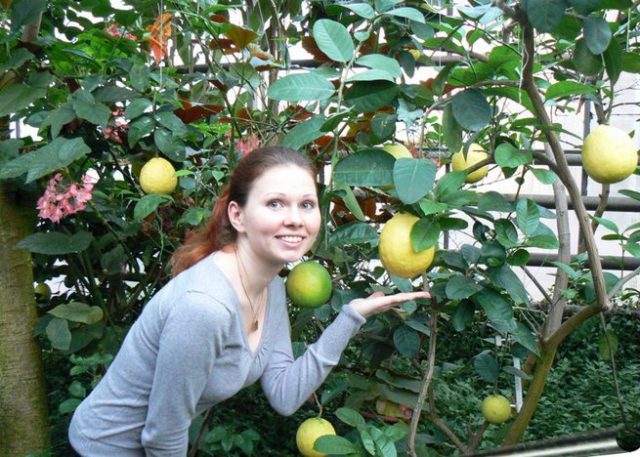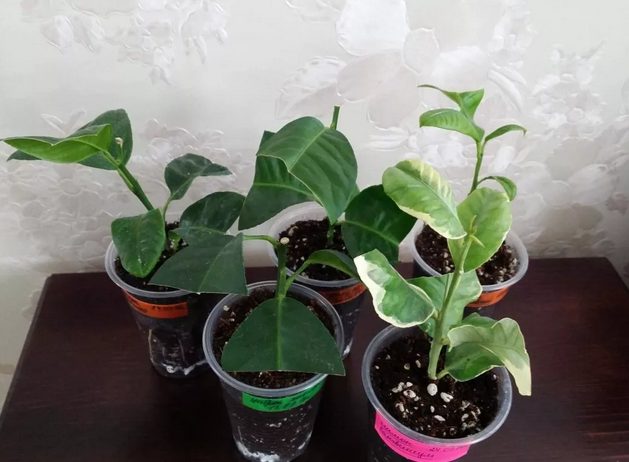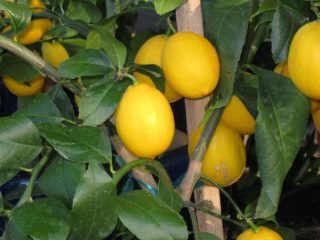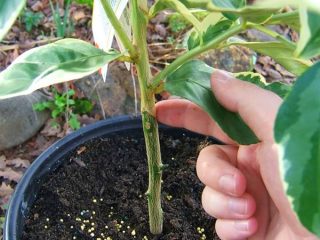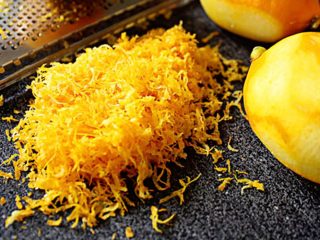Content
Jubilee lemon appeared in Uzbekistan. Its author is breeder Zainiddin Fakhrutdinov; he obtained a new large-fruited citrus by crossing the Tashkent and Novogruzinsky varieties.
Description of the variety
The Yubileiny variety lemon is an evergreen plant whose height does not exceed 1.5 m. The variety is large-fruited and intended for indoor growing. Blooms abundantly, in clusters. Sometimes bouquet branches appear to the detriment of growth. The seedling grows well without a rootstock, on its own roots. The crown is compact and is formed by pruning. The shoots are strong, directed upward, and can bend under the weight of the fruit. For rapid development, warmth, good lighting and high humidity are required.
The leaves are oblong, dense, glossy, bright green, located on short petioles. Their large size makes them look decorative. The peculiarity of the Jubilee lemon variety is that milky-white, fragrant flowers bloom on it and the fruits ripen at the same time.
The fruits are large, weighing from 200 to 800 g, with a pleasant sour taste, without bitterness. The peel is yellow, of medium thickness. The pulp is light yellow, very juicy, with a large number of seeds, and has a pronounced grapefruit aroma.Lemons ripen for 8-10 months, it all depends on lighting and care. It is necessary to tie up the shoots during the ripening of the crop. The tree begins to bloom and bear fruit in the 2nd year of cultivation. It is better to pick off green ovaries before the age of 4, until the seedling gains strength for full fruiting.
The Yubileiny lemon shown in the photo above is a remontant one; it can bloom and bear fruit several times a year. The Yubileiny variety is resistant to unfavorable conditions; the plant is unpretentious to soil, lighting, humidity and temperature, but responds gratefully to care.
Lighting is of great importance for the Jubilee lemon variety. It grows and bears fruit best on the sunny side. The soil should be slightly acidic, about 6 pH; ready-made soil for citrus fruits can be bought in the store. The Jubilee lemon variety develops unevenly; it has a period when new branches and leaves are formed very actively. This is replaced by a time of dormancy, when active growth is unnoticeable, and the wood ripens. The seasonal change in temperature is important: above 18 °C in summer and about 14 °C in winter.
In the spring, the Jubilee lemon variety is replanted. The balance between the volume of the root system and the soil is important for normal development. If there is too much soil in the planting container, it turns sour and the roots begin to rot. Therefore, the diameter of the pot is increased gradually when transplanting.
In summer, the Jubilee lemon can be taken out into the garden and placed in the shade of a tree. It is better to cover the pot with some material so that it does not overheat. The tree must be sprayed early in the morning; it loves high humidity. In the summer, this can be done every day, and in the winter - as needed. The air humidity in the room should be about 70%.
Advantages and disadvantages
The advantages of the Yubileiny variety are:
- earlier fruiting;
- abundant flowering;
- large fruit size.
Jubilee lemon is unpretentious, responds well to fertilizing and a favorable microclimate, but can bear fruit even with minimal care.
The disadvantages include the slow growth of new shoots with abundant flowering.
Reproduction methods
Lemons grown from seeds do not retain varietal characteristics. Such seedlings can be used as rootstock. The scion is taken from the Jubilee lemon variety, which is already bearing fruit. The cut areas are treated with garden varnish.
The procedure for growing lemon seedlings of the Yubileiny variety:
- the seed is removed from the fruit and dried in air for several hours;
- then planted in the ground and watered;
- sprouts will appear in about 3 weeks;
- When the seedlings are a month old, they are planted in individual containers.
It is easier to grow a seedling from a cutting.
You can make a greenhouse from a 2-liter plastic bottle. To do this, it is cut horizontally into 2 parts. Drainage holes are made in the lower half, a layer of expanded clay and soil are poured.
Instructions for rooting lemon cuttings of the Yubileiny variety:
- Fill the planting container with citrus soil mixed with coarse sand.
- The cutting is cut about 10 cm long, the lower leaves are torn off, and the cut is renewed under the lower bud.
- Place it in the Kornevin solution for 1 day, then plant it in a greenhouse.
- The wide top leaf of the cutting is cut in half to reduce moisture evaporation.
- The stem is deepened into the soil by 2-3 cm.
- Water it with Heteroauxin and cover the greenhouse with the top, cut part of the bottle.
- Drain the drained liquid from the pan.
- Once every 2 days, the cuttings are ventilated by unscrewing the cap on the bottle.
- Rooting will occur in about a month.
- The Yubileiny variety lemon will begin to bear fruit in the 2nd year of cultivation.
Citrus fruits are propagated by seeds, cuttings and grafting. When propagating from seeds, you should not expect fruit to appear; you will need to graft a fruit-bearing branch onto the seedling. Only an experienced plant grower can do the grafting correctly.
When propagated by cuttings, all varietal characteristics are preserved; the Jubilee lemon variety quickly enters the fruiting season. This means the best way to propagate at home is cuttings.
Landing rules
A week after purchasing a young lemon of the Yubileiny variety, it needs to be transplanted into a new pot and fresh soil using the transshipment method. You cannot buy a seedling with a bare root system; it will not take root. The Jubilee lemon variety needs annual spring replanting before flowering begins. Old plants in large pots are replanted once every 2-3 years or simply change the top layer of soil.
Procedure:
- For transplantation, take a container 2-3 cm larger in diameter than the previous one.
- A 4 cm layer of drainage is poured onto the bottom, and part of the soil is placed on top.
- When transplanting, the earthen ball around the roots is not destroyed.
- If the Jubilee lemon seedling is small, hold the trunk between your fingers and take it out of the pot along with the soil.
- Shake off the crumbled soil and place an earthen ball with roots in the center of the new planting container.
- Add fresh soil and compact it by lightly tapping the pot on a hard surface.
- Water well and place in diffused light.
Observe the development of a young lemon of the Yubileiny variety. When roots appear from the drainage hole, move them to a larger pot without waiting for spring.
Caring for Jubilee lemon at home
In summer, the temperature should be between 18 and 26 °C. Such conditions are ideal for the formation of flowers. In winter, it is advisable to maintain a room temperature of about 14 °C. Lemon Jubilee can be placed on an insulated loggia or a cool windowsill. The heating should be the same at the roots and crown. If the floor is cold or, conversely, heated, the pot must be raised on a stand so that the heat is distributed evenly.
Bright, diffused light is useful in spring and autumn. In summer, Jubilee lemon variety should be shaded from the hot, midday rays of the sun. In winter, additional lighting is necessary, otherwise the leaves will begin to fall off. Air humidity should be high, about 70%; you can use a humidifier or spray regularly.
The soil should not be overwatered or overdried so that the mycorrhiza does not die. To check soil moisture, you can use a special device - an indicator. If the arrow is in the center, then the Jubilee lemon variety will wait another day for watering; if it deviates to the left, watering is necessary.
The top of a 2-year-old Jubilee lemon seedling is trimmed in January. In about a month, young shoots will begin to grow from the awakened 3-4 lateral buds. Another year later, when the new branches have matured, they are cut off again, leaving 3-4 internodes, and thus the third-order branching continues.
In the spring, the Yubileiny lemon variety, which has reached 5 years of age, is washed from the soil to remove accumulated salts. To do this, remove the top layer of soil from the pot down to the roots. Then water with warm filtered water. Yellow liquid will begin to flow through the drain. Continue watering until clean water flows into the pan. Then they take the flowerpot with lemon to its place and add fresh soil.
It is advisable to pick off the first flowers. If the Jubilee lemon has bloomed, for successful fruiting it must have at least 30 well-developed leaves. Adult plants regulate the harvest themselves, shedding all excess ovaries. Citrus fruits have bisexual flowers, but to ensure the appearance of fruits, you can help with pollination using a soft brush.
During active growth and flowering, when the ovaries appear, Jubilee lemon needs intensive feeding. There are specialized humic fertilizers for lemons. They have an organic base - compost and chicken manure with the addition of trace elements. Before use, the drug is diluted in water (1 tablespoon per 1 liter of water or according to the instructions) and left for at least 2 hours. Feeding is carried out once every 2 weeks.
Pests and diseases
Adult lemons of the Yubileiny variety are bought in the store carefully; they will require careful care.
The diseased Jubilee lemon is treated with an insecticide and transplanted into fresh soil. Place a transparent plastic bag over the crown and ventilate it daily. After 5 days, the top part of the bag is cut off, then it is removed completely. The fruits must be removed so as not to overload the tree.
Pests can slow down growth and reduce yield:
- They bring great harm scale insectsunable to move. Insects attach to leaves and feed on plant sap. To combat, use the drug “Aktara”, pouring Jubilee lemon at the root. It is advisable to first collect the insects by hand using a cotton swab moistened with salicylic alcohol.
- Spider mite appears on Jubilee lemon most often. It is brought in with new cuttings or flowers cut for bouquets. On a diseased plant, you can see cobwebs between the shoots. Treatment against ticks is carried out with Fitoverm. The drug does not affect eggs, so spraying is repeated after 5 days.
- Fungus gnats And mealybugs start from excessive watering. Pests can be controlled with systemic insecticides.
Dark spots on the leaves can appear when the tree is overfed or infected with sooty fungus. Jubilee lemon is susceptible to various fungal diseases, which can be easily eliminated with the fungicide “Fitosporin” when sprayed and watered at the root. Preventive treatments can be carried out using a soap solution.
If overwatered, the roots rot. Necrotic spots form on the leaves and they begin to fall off. It is necessary to wash the roots, remove all rotten parts by trimming them with pruning shears, powder them with crushed coal and plant them in new soil.
Conclusion
Jubilee lemon bears fruit in the 2nd year of cultivation. With good care of the plant, it will live a long time, and the fruits will be large.
Throughout the year, you need to carry out regular watering and fertilizing, destroy pests in a timely manner, form a crown and replant the plant in fresh, fertile soil.
